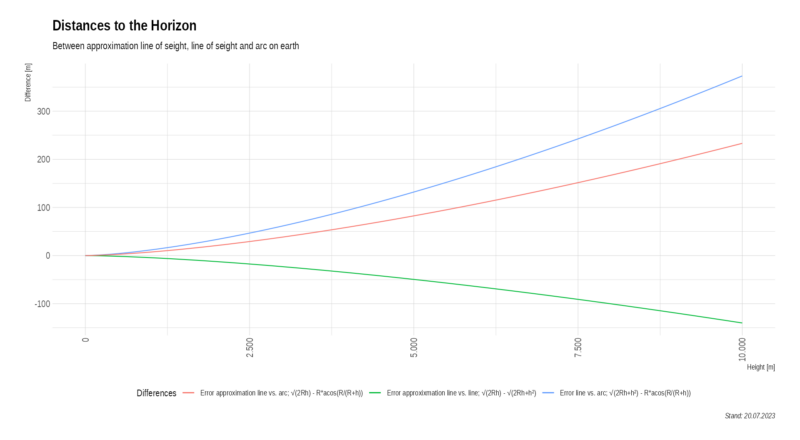Flat-Earthists ( see: Zetetic astronomy. Earth not a globe! an experimental inquiry into the true … from Samuel Birley Rowbotham) always claim that the curvature of the Earth is eight inches per mile squared. Sometimes Flat Earthers are taught that this is not the correct formula and that a sphere is not a parabola. That’s basically true, but where does this rule of thumb come from?
The distance d from the height of the eye h to the horizon can be calculated on a sphere using the formula of Pythagoras (R + h)² = R² + d², where R is the radius of the sphere. From this formula, a rule of thumb for small heights can be derived as follows.
![( R + h ) ^ 2 = R ^ 2 + d ^ 2 R ^ 2 +2 * R * h + h ^ 2 = R ^ 2 + d ^ 2 2 * R * h + h ^ 2= d ^ 2 with R >> h => 2 * R * h approx d ^ 2 h approx { d ^ 2 } over { 2 * R } with R approx 6371000 m => h approx 7.8481 * 10 ^ - 8 [m^-2] * d ^ 2 or : 7.8481 cm / km ^ 2](https://byggvir.de/wp-content/uploads/2023/08/Herleitung-Naeherung.png)
In the metric system we get about 8 cm per distance kilometer squared. That equates to 8 inches per mile squared.
The following diagram shows the difference between the approximation formula and the exact value and the distance from the base of the observation to the horizon.

The distance to the horizon at an altitude of 10,000 m is 357099.4 m. The difference of -140 m to the result of the approximation formula is negligible at -0.04%. Conversely, to determine eye level from a distance, the formula can also be used. When rounded up to 8 cm, the relative error is less than 2%.
Conclusion
For practical applications, the rule of thumb is sufficiently accurate. Especially when it comes to determining the invisible height behind the horizon in images with poor resolution.


Neueste Kommentare